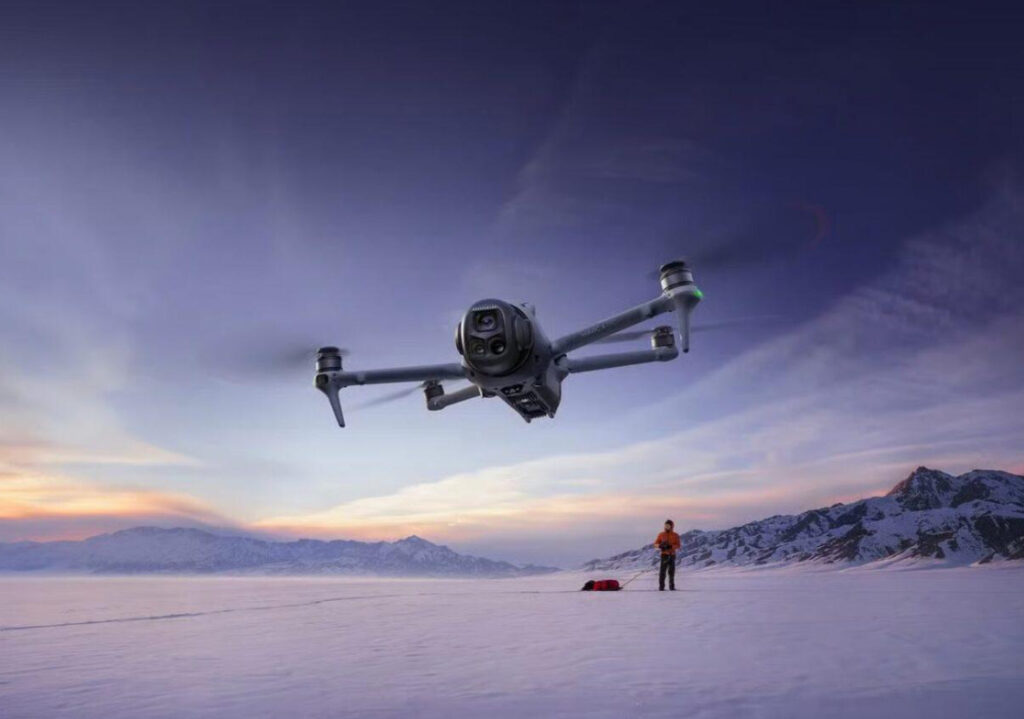In the ever-accelerating race to bridge cinematography, automation, and airborne engineering, DJI stands uncontested as the industry’s chief architect. The launch of the Mavic 4 Pro, outfitted with a revolutionary triple-camera array, is not simply an update—it is a reorientation. A redefinition of what it means to shoot, direct, and compose in three-dimensional space. This isn’t just a drone; it’s a portable aerial production suite.
The Mavic 4 Pro marks a significant leap from its predecessor, the already formidable Mavic 3, introducing enhanced camera versatility, longer flight times, elevated processing power, and a design philosophy that balances refinement with professional ambition. Where previous iterations targeted high-end prosumers and indie filmmakers, the Mavic 4 Pro makes a claim to cinematic legitimacy. It’s a tool not merely of recreation or content creation, but of authorship—allowing photographers, directors, surveyors, and artists alike to wield near-cinematic control over sky-borne optics.
A Triple Threat in the Sky
The cornerstone of the Mavic 4 Pro’s innovation is undoubtedly its tri-camera system, a feature previously rumored but now delivered with DJI’s signature attention to optical detail. Each of the three cameras serves a distinct purpose, and together they form a modular narrative device for aerial storytelling.
- Wide-Angle Flagship Camera:
The primary shooter is a 4/3 CMOS Hasselblad sensor, a refined evolution of the Mavic 3’s iconic lens. Boasting 24mm equivalent focal length, a variable aperture from f/2.8 to f/11, and the ability to shoot 5.7K at 60fps, this camera delivers depth-rich color science, lifelike shadow gradation, and a dynamic range that brushes shoulders with RED and ARRI territory—without the logistical overhead. - Medium Telephoto Camera:
Sitting in the middle is a 70mm equivalent lens designed for parallax-rich compression. Ideal for cinematic reveals, dolly-style zooms, and layered compositions, this camera offers 2x optical zoom, 1-inch sensor fidelity, and HDR video capture. It is, in many ways, the unsung hero of the Mavic 4’s aerial language—a viewpoint that bridges intimacy with scope. - Super-Telephoto Camera:
Perhaps the most dramatic addition is the new 166mm equivalent periscope telephoto, capable of 10x hybrid zoom and 4K video at 60fps. Previously a novelty in the Mavic 3’s tele system, the Mavic 4’s long lens is now precise, stabilized, and surprisingly color-consistent across focal lengths. It’s the drone for wildlife cinematographers, surveillance creatives, and cityscape explorers who seek distance without sacrifice.
These three cameras, when used together, allow drone operators to move through scenes like a director behind multiple lenses—punching in, drawing back, capturing the macro and the minute, all mid-flight. The result? Unparalleled control over spatial storytelling.
Intelligent Flight Meets Filmmaking Autonomy
Equipped with O4 transmission technology, the Mavic 4 Pro guarantees 1080p live video at up to 20km with rock-solid signal stability. But DJI doesn’t stop at range—it upgrades the aircraft’s autonomous intelligence with the new ActiveTrack 6.0 and Advanced Smart Composition Suite.
The drone’s onboard AI can now detect multiple subjects, assign framing priority, and execute complex flight paths like orbital sweeps, vertical pull-backs, and multi-lens transitions automatically. All of this is executed with millisecond-level obstacle avoidance powered by the Omnidirectional Sensing Array—a network of binocular vision sensors that create a real-time 3D model of the drone’s environment.
DJI’s new Smart Focus Racking, inspired by cinema follow-focus rigs, uses predictive AI to shift between focal points across the three lenses. This allows for dynamic shifts in perspective—foreground to background, tight to wide—in ways that previously required ground-based gear or hours of post-production.
A Design That Serves Vision
The Mavic 4 Pro maintains the signature foldable chassis, keeping portability sacred for the solo creator or mobile crew. But this generation features aerodynamic refinements that reduce drag by 15%, as well as enhanced thermal efficiency, ensuring that even under high-load tasks—like multi-lens 5.7K video capture—the drone remains cool and responsive.
Flight time is extended to 48 minutes per charge, thanks to the new IntelliCell battery system, which balances cell draw to maximize air time without risking performance dips. The redesigned propellers, meanwhile, are quieter and more vibration-resistant, making for cleaner audio when paired with DJI’s onboard directional microphone array, another new feature geared toward on-location documentation.
And then there’s the controller: DJI’s RC Pro+ comes standard with a bright 1200-nit display, customizable dials, and the new Lens Switcher Dial—allowing pilots to swap between the three cameras mid-flight with tactile control. It’s not a toy. It’s a control deck.
Color Science, Codec, and Post-Production
DJI’s partnership with Hasselblad again pays dividends with the Mavic 4 Pro’s color pipeline. The drone captures in 10-bit D-Log M and Apple ProRes 422 HQ, with optional support for RAW video recording in the Pro Cine version. DJI has even introduced DJI LUT Studio, a lightweight companion app that allows filmmakers to preview and apply color grades live, on set, in the field.
Gone are the days of uncertain exposure in harsh daylight or desaturated footage needing deep correction. DJI’s Hasselblad Natural Colour Solution (HNCS) continues to deliver skin tones that feel human, not machine-learned. The consistency across all three lenses in terms of white balance, sharpness curve, and tonal continuity is near unprecedented in drone filmmaking.
Use Cases Beyond Cinema
While clearly geared toward filmmakers, the Mavic 4 Pro’s triple-camera setup and intelligent flight tools are just as useful for other professionals. Architectural surveyors, for example, can now capture facade details with telephoto clarity, while simultaneously framing the surrounding context. Agricultural inspectors can sweep vast fields with wide lenses, then zoom in to diagnose micro-patterns of crop stress.
In search and rescue operations, the drone’s long lens and AI subject tracking become invaluable. Environmental conservationists can document elusive species without intruding. Even law enforcement and disaster response teams benefit from the precision and discretion enabled by silent operation and long-distance visual fidelity.
Pricing, Variants, and Accessibility
The Mavic 4 Pro comes in three editions:
- Standard – with full camera system and RC Pro+ controller.
- Cine Edition – adds internal SSD, ProRes RAW support, and DJI LUT Studio license.
- Enterprise Edition – features modular payload support and encrypted data handling.
Pricing begins at $2,199 USD, a justifiable leap for what is effectively a full production suite. The Cine Edition pushes into the $3,500–$4,000 range, while the Enterprise variant is priced according to custom configurations.
DJI has also committed to a new Creative Access Program, offering discounts and financing for independent filmmakers, nonprofit journalists, and students. The goal is to democratize access to high-end aerial imagery—something DJI has always subtly championed, even as their technology has pushed into professional extremes.
Beyond the Horizon
The Mavic 4 Pro is not just an upgrade. It is a redefinition of what a drone can be when treated as an instrument of vision rather than a novelty of flight. The triple-camera system, once a sci-fi wishlist item, is now a real tool in the hands of creators who demand options, flexibility, and storytelling range from their gear.
By integrating cinematic optics, intelligent AI movement, and professional post-production tools into a device that fits in a backpack, DJI has created something radical: a sky-borne companion for serious visual work. It marks the moment where drones cease to be auxiliary—and begin to lead the shot.
In a landscape defined by compression, compromise, and creative constraint, the Mavic 4 Pro invites something rare: possibility. Not just of flight, but of seeing—more clearly, more intimately, more completely than ever before.
No comments yet.







